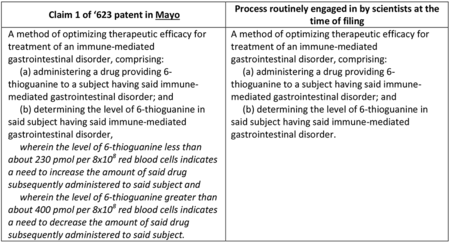 On March 4, the U.S. Patent and Trademark Office issued a guidance memorandum, entitled "Guidance For Determining Subject Matter Eligibility Of Claims Reciting Or Involving Laws of Nature, Natural Phenomena, & Natural Products" (or "Myriad-Mayo Guidance"), to implement a new procedure for determining the subject matter eligibility of claims under 35 U.S.C. § 101 in view of the Supreme Court's decisions in Association for Molecular Pathology v. Myriad Genetics, Inc. (2013), and Mayo Collaborative Services v. Prometheus Laboratories, Inc. (2012). At a public forum hosted at the USPTO in May, the Office encouraged shareholders to submit written comments on the Guidance. Since the forum, the Office has encouraged the patent community to provide further feedback regarding the Guidance (despite the Office's announced deadline of July 31 for submitting comments).
On March 4, the U.S. Patent and Trademark Office issued a guidance memorandum, entitled "Guidance For Determining Subject Matter Eligibility Of Claims Reciting Or Involving Laws of Nature, Natural Phenomena, & Natural Products" (or "Myriad-Mayo Guidance"), to implement a new procedure for determining the subject matter eligibility of claims under 35 U.S.C. § 101 in view of the Supreme Court's decisions in Association for Molecular Pathology v. Myriad Genetics, Inc. (2013), and Mayo Collaborative Services v. Prometheus Laboratories, Inc. (2012). At a public forum hosted at the USPTO in May, the Office encouraged shareholders to submit written comments on the Guidance. Since the forum, the Office has encouraged the patent community to provide further feedback regarding the Guidance (despite the Office's announced deadline of July 31 for submitting comments).
Comments regarding the Guidance, including five received after the July 31 deadline, have been posted on the USPTO website. The comments have been divided into seven groups (with the number of submissions in each group also provided): Intellectual property organizations and other associations (21), government agencies (0), academic and research institutions (4), law firms (7), companies (8), individuals (43), and comments received after August 1, 2014 (5). Yesterday, we presented Part I of an examination of comments submitted on August 6, 2014 by The Coalition for 21st Century Medicine (note: the Coalition also was a signatory on joint comments submitted on October 14, 2014 by the Biotechnology Industry Organization, five companies, and six individuals (see "Examination of Myriad-Mayo Guidance Comments -- BIO Joint Comment")). Today, we present Part II of our examination of the Coalition's comments.
The Coalition's 45-page letter provides proposed examination processes for analyzing composition claims and method claims (pages 3-12) and more than 30 pages of examples providing 41 exemplary claims and an analysis of each claim under the Coalition's proposed "practical framework". In Part I of our examination of the Coalition's comments, we discussed the group's proposed process for analyzing composition claims. Today, we discuss the Coalition's proposed process for analyzing method claims. In a subsequent post, we will examine some of the examples and exemplary claims set forth in the Coalition's letter.
With respect to method claims, the Coalition contends that:
The case law urges a fairly simple threshold question: "Has the applicant claimed a law of nature per se?" While claims to laws of nature per se are ineligible, claims to applications of laws of nature are eligible.
The letter notes that this two-step analysis was set forth in Mayo, as discussed by the Court in Alice Corp. v. CLS Bank Int’l. (2014):
In Mayo Collaborative Services v. Prometheus Laboratories, Inc. we set forth a framework for distinguishing patents that claim laws of nature, natural phenomena, and abstract ideas from those that claim patent-eligible applications of those concepts. First, we determine whether the claims at issue are directed to one of those patent-ineligible concepts. If so, we then ask, "[w]hat else is there in the claims before us?"(internal citations omitted).
The Coalition explains that "[b]ecause applicants are unlikely to explicitly claim a bare law of nature, precedent urges patent reviewers to look a little closer at method claims to make sure the applicant hasn't in effect claimed the law of nature by, e.g., merely including a token reference to 'applying' the law of nature." However, the Coalition argues that "[t]his caution from the courts should not be over read, however, to mean that broad applications are categorically ineligible or that method claims must recite specifics of the process at arbitrarily high levels of detail."
In examining method claims for subject matter eligibility, the Coalition suggests that the following questions be addressed:
1. Does the claim appear, on its face, to recite a natural principle?
2. What is the natural principle potentially claimed and how is it recited in the claim?
3. Does the claim recite a process that is different in any way from that which is well understood, routine and conventional in the art?
With respect to the first question, the letter notes that:
The primary cases in this area are Benson, Flook, Diehr, Mayo, and Alice. These cases tend to give not an actual analytical framework but instead examples from which general principles of analysis can be gleaned. For example, Benson, Flook and Diehr together teach that a claim reciting a mathematical algorithm facially raises the question of whether an abstract idea is being claimed. This is not to say that all claims involving such an algorithm are improperly directed to an abstract idea, as made clear by Diehr. Instead, these cases teach that the presence of the algorithm facially raises the issue and warrants further analysis . . . ."
Mayo similarly teaches that "wherein" clauses in a method claim will often facially raise the question of whether an abstract idea or natural principle is being claimed. Again, this is not because "wherein" clauses are always problematic. Such clauses can often recite important structure or steps in a process that meaningfully limit a claim to an application of a natural principle.
Moving on to the second question, the Coalition declares that "[t]his may be the most important part of the analysis," adding that in answering the question, "[i]t is critical to understand the difference between a law of nature and a statistical correlation." The Coalition then points to gravity as an example of a law of nature, and the relationship between a numerical gene expression score and the presence of brain cancer as an example of a statistical correlation. The letter then explains that:
There cannot be any single, direct mechanistic connection between a human-created numerical score (i.e., a number) and the presence of the disease. . . . [T]he critical question is whether humans truly made the process or not. No human made gravity; we simply discovered it and the natural laws by which it operates. A human created the numerical expression score and likewise "created" the correlation through statistics (a human-created mathematical endeavor).
Nevertheless, the letter acknowledges that "a claim to a statistical correlation may not be patent-eligible as it is arguably an abstract idea." As an example, the letter suggests that if one determines that obese patients tend to have higher blood lipid levels, one "cannot claim 'the correlation between obesity and blood lipid levels' or even 'a method comprising determining whether a patient is obese, wherein obesity indicates (or correlates to) increased blood lipid levels,'" but rather "must claim an application of the statistical correlation such as a method of using obesity as a prescreen for determining which patients should have their blood lipid levels tested."
The Coalition then discusses the final prong of its proposed process of analyzing method claims. In answering the third question, the Coalition suggests that "one helpful way to assess whether a natural principle is being claimed is to find the closest prior art process and compare it side-by-side to the claimed process." The letter uses the Mayo case as an example of such a comparison, providing the following chart:

The letter states that:
The [Mayo] Court found that the only difference between the prior art method and the claimed method was the "wherein" clauses. But these merely describe (or inform an audience about) a pre-existing but newly "discovered" fact about the process; they do not specify any new or even modified step, structure or element of the process. In this way they are not truly a part of the process and do not "meaningfully limit" the claim (or even limit it at all). This simple fact is the central reason the claims in Mayo were patent ineligible[.]
Despite asking whether a claim recites a process that differs from that which is well understood, routine and conventional in the art, the Coalition argues that "[i]t is critical to recognize that, despite the use of terms like 'well-understood,' 'routine,' or 'conventional,' this is not an obviousness analysis." In particular, the Coalition contends that "[a] claimed process is not ineligible simply because it differs from what was routine and conventional in a way that, in view of the newly discovered natural principle, would have been obvious."
In a subsequent post, we will examine some of the examples and exemplary claims set forth in the Coalition's letter and how the group applies its proposed examination processes for analyzing composition claims and method claims to those exemplary claims.
For additional information regarding this topic, please see:
• "Examination of Myriad-Mayo Guidance Comments -- The Coalition for 21st Century Medicine," Ecember 1, 2014
• "BIO IPCC Panel Discusses Impact of Myriad-Mayo Guidance," November 13, 2014
• "USPTO Provides Update on Status of Revised Myriad-Mayo Guidance," November 12, 2014
• "Examination of Myriad-Mayo Guidance Comments -- University Community Joint Comment," October 28, 2014
• "Examination of Myriad-Mayo Guidance Comments -- BIO Joint Comment," October 23, 2014
• "Sherry Knowles Addresses Real World Impact of Myriad-Mayo Guidance at BIO Symposium," October 15, 2014
• "Guest Post: Myriad -- A Direct and Unexceptional Approach," October 12, 2014
• "USPTO Outlines Changes to Myriad-Mayo Guidance at BIO Symposium," September 30, 2014
• "USPTO Expected to Issue Revised Myriad-Mayo Guidance in October," September 17, 2014
• "Guest Post: Myriad-Mayo Guidance -- Consistency With International Harmonization and TRIPS," August 26, 2014
• "Examination of Myriad-Mayo Guidance Comments -- AUTM, COGR, AAU, and APLU," August 21, 2014
• "Examination of Myriad-Mayo Guidance Comments -- International Bioindustry Associations," August 11, 2014
• "Examination of Myriad-Mayo Guidance Comments -- ACLU," August 5, 2014
• "Guest Post: Overview of First Published Comments on Myriad-Mayo Patent Eligibility Guidance," July 13, 2014
• "Guest Post: USPTO Public Forum on Patent Guidance: My Thoughts as a Speaker and Attendee," June 11, 2014
• "USPTO Holds Forum on Subject Matter Eligibility -- Part IV," May 22, 2014
• "USPTO Holds Forum on Subject Matter Eligibility -- Part III," May 15, 2014
• "USPTO Holds Forum on Subject Matter Eligibility -- Part II," May 14, 2014
• "Guest Post: How to Patent Grapefruit Juice -- The New USPTO Guidance for Patent Eligible Subject Matter Is Both Sticky and Sour," May 13, 2014
• "USPTO Holds Forum on Subject Matter Eligibility -- Part I," May 12, 2014
• "USPTO Tries to Address Public Misunderstandings Regarding Myriad-Mayo Guidance," April 16, 2014
• "USPTO Issues Guidance for Analyzing Subject Matter Eligibility of Claims Reciting Laws of Nature/Natural Principles, Natural Phenomena or Natural Products," March 4, 2014